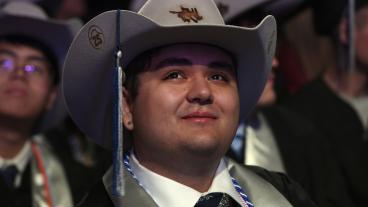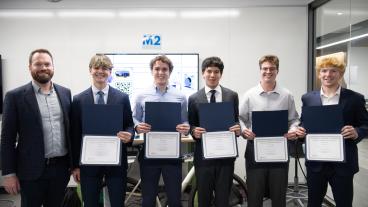A virtual reality app that encourages people with neck injuries to do muscular exercises, an automated parking lot assistant to help find that elusive parking spot on campus and an inventory tracking system built around a Wii Fit balance board – those are just a handful of the ideas dreamed up and prototyped by Colorado School of Mines students in recent months.
And they did it all in a matter of hours, too.
More and more Mines students are attending hackathons – “invention marathons” where programmers and technology enthusiasts get together for lots of coding and a lot less sleeping – and they’re making a name for themselves while they’re at it.
Earlier this month, the Mines team of Joshua Rands, Seth Asadi, Matt Wojnoski and Ethan Bond took second place in the 54-hour BattleBorn Hackathon in Las Vegas, claiming a $5,000 cash prize for BridgeBox, a system of sensors connected to mining equipment designed to help operators easily identify and check the “health” of the machinery and submit work orders if needed.
In February, two Mines teams won prizes at HackCU, a 24-hour hackathon that welcomed 600 coders to the University of Colorado Boulder for multiple challenges. One of the teams earned an interview opportunity with a national software firm that has a development center in Colorado. Another won three awards – including the chance to demo their prototype for executives at Dish Network.
“Hackathons are such an excellent educational experience for our students, giving them the opportunity to learn new technical skills and advance their problem-solving skills, as well as meet company representatives and have fun with peers,” said Tracy Camp, professor and head of the Computer Science Department at Mines. “I am thrilled that CS@Mines students are participating in more hackathons than ever before.”
In recent months, Mines has also sent students to FC Bayern HackDays in Munich, Germany, HackHarvard and Hacktech at Caltech. Two other Mines computer science students, Nhan Tran and Ryan Hunt, will spend part of their spring break at HackPrinceton.
“One of the cool things about hackathons is that you have an opportunity to build a project from the ground up,” said Sumner Evans, a senior majoring in computer science and vice president of the Mines student chapter of the Association for Computing Machinery (ACM). “I really like that because you basically get to do the entire software engineering process in a short amount of time.”
Evans was part of the Mines team that took first place in the Dish Network Challenge at HackCU, along with fellow computer science majors David Florness and Jack Garner and electrical engineering major Robby Zampino. They also won Judges’ Favorite and Best Use of Amazon Web Services (AWS).
Their "Wii-Track" inventory tracking system utilized a Wii Fit board as its "scale" and a Raspberry Pi camera controlled by an Arduino to take pictures of packages. It used the computing power of AWS Lambda and the flexibility of the DynamoDB NoSQL database to detect packages automatically.
Hackathons are a great way to get experience with new technologies, said Evans, who was also a member of the Mines team that won the Xilinx Hackathon with its parking lot assistant last semester.
“At Xilinx, I learned how to use the PYNQ board, which none of our team had experience with. At MinneHack earlier this semester, I learned how to use IPFS. At HackCU, I learned how to use AWS Lambda and AWS DynamoDB, neither of which I knew much about going into the hackathon,” he said.
Evans’ team wasn’t the only one from Mines to fare well at HackCU. Computer science major Tyler Quast, civil engineering major Ben Lin and future Mines student Alejandro Martinez placed second in the Alteryx Challenge, in which teams were given an unexplained data set and had to determine what specific event they were talking about and predict its attendance. As one of the top three teams, their prize included an invitation for interviews at the Alteryx office in Broomfield.
Quast, who was also among the Mines contingent at BattleBorn, said event sponsors often pay for everything – travel, housing and even food for the entire weekend.
“The projects I build are really something I take a lot of pride in,” Quast said. “Every hackathon I have gone to is on my resume and it's frequently the first thing interviewers ask me about.”
In January, Mines computer science majors Megan Kallis, Robbie Merillat and Sam Sartor took second place at MinneHack, a 24-hour hackathon hosted at the University of Minnesota, for their Google Cardboard VR app to “gamify” muscular exercises for people with neck injuries.
“It teaches you how to work efficiently under a time constraint – we were told the prompt for our project at 7 p.m. on Saturday, and it was hands off keyboards and time for judging at 2 p.m. the next day,” Kallis said. “With less than 24 hours to come up with an idea, work with your team to implement it and try to get a couple hours of sleep in between, you really have to know how to prioritize what needs to be done, how to work together cohesively and how to really sell your idea.”
And contrary to popular belief, you don’t necessarily need programming experience to participate in a hackathon, Wojnoski said. His second place-winning team at BattleBorn was made up of two computer science majors (Joshua Rands and Seth Asadi), one engineering physics major (Ethan Bond) and himself, a mechanical engineering major.
“In fact, it’s recommended to have students from different backgrounds compete in order to get a diverse team,” Wojnoski said. “A diverse team leads to diverse ideas, which is exactly what hackathons are all about.”
CONTACT
Emilie Rusch, Public Information Specialist, Communications and Marketing | 303-273-3361 | erusch@mines.edu
Mark Ramirez, Managing Editor, Communications and Marketing | 303-273-3088 | ramirez@mines.edu



